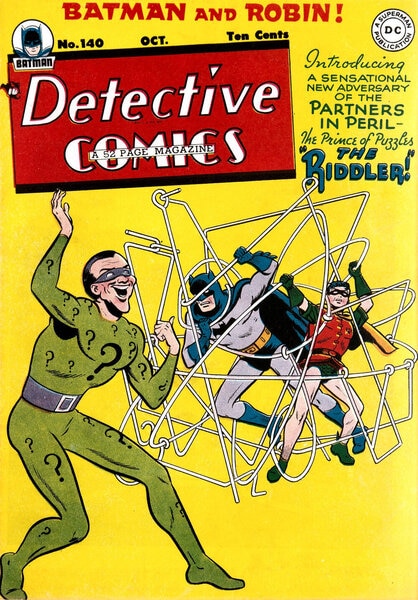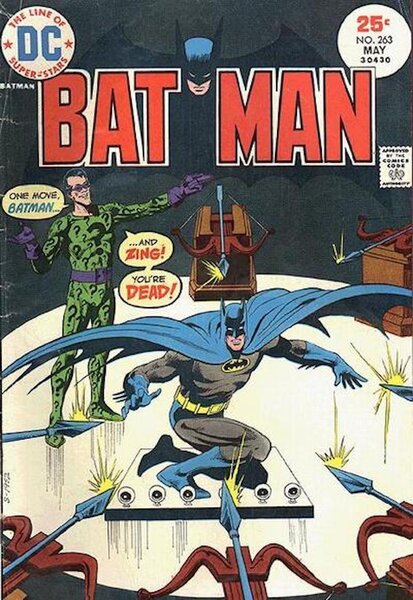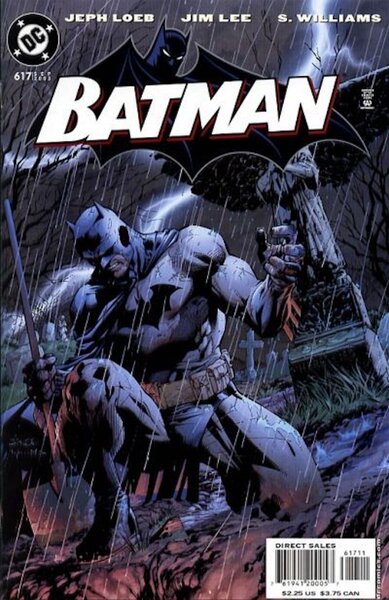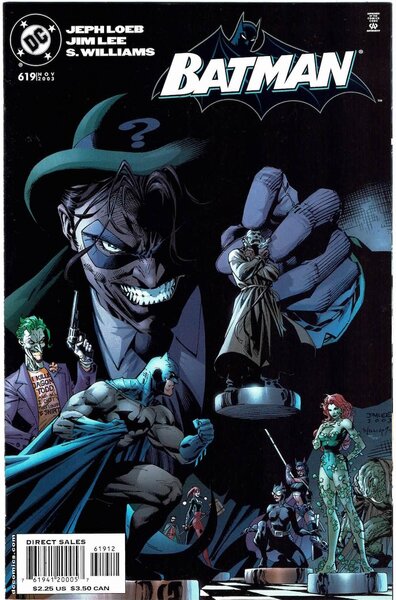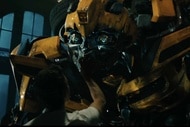Create a free profile to get unlimited access to exclusive videos, sweepstakes, and more!
'Hush': How this classic DC Comic paved the way for The Batman's Riddler
20 years ago, this iconic story reminded fans and Batman himself why they shouldn't underestimate Edward Nigma.
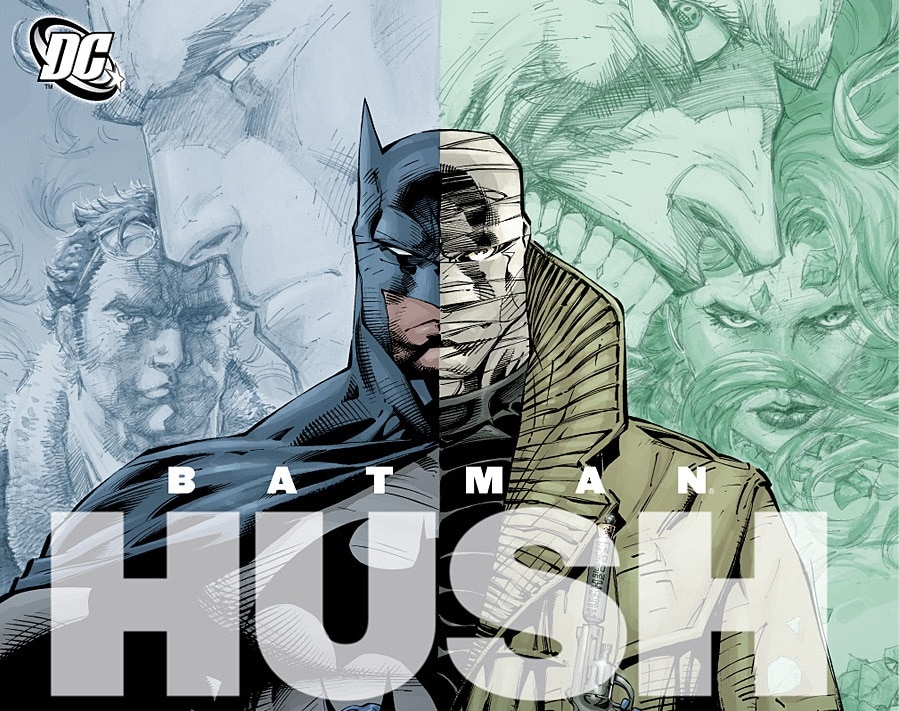
Batman's rogues gallery is generally considered the best in comics, although one can certainly make persuasive arguments in favor of Spider-Man, the Fantastic Four, or even the Flash's rogues. But the book that really solidified that the Dark Knight's enemies were the best of the worst, is DC's Batman: Hush.
The problem with Batman's most recognizable baddies, however, is that some of them struggle to measure up as a credible threat, especially for a hero of Batman's caliber (think the Mad Hatter or even the Penguin). Before Hush, the Riddler served as a prime example of a villain who seemed less like a formidable foe for the Caped Crusader, and more like a novel nuisance.
Hush changed all that.
For a long time in the comics, prior to Hush, Riddler was a bigger clown than the Joker, a criminal curiosity in a onesie who basically begged to get caught by leaving clues for the world's greatest detective. He all but guaranteed his plans would fail, which sort of gives away the punchline before you tell the joke. Part of the Riddler's lameness came from his Golden Age origins. Back then, one-note gimmicks were de riguer for comic book baddies. Simpler times, and all that.
Clearly, DC Comics editors realized the Riddler was a cut below Batman's other foes since he was off the canvas during much of the caped crusader's Silver Age silliness. During a time when Batman faced ludicrous threats from the likes of the Calendar Man and the Eraser, the Riddler was nowhere to be found. In fact, after making his debut in 1948’s Detective Comics #148, the Riddler wasn’t seen again for 17 years!
Poor Edward.
He returned in Batman #171, making his first Silver Age appearance in a story dubiously called “The Remarkable Ruse of the Riddler.” But despite the fact Frank Gorshin made the master of Riddles perhaps the most entertaining of Batman’s adversaries on the camp classic tv series of the era, the Riddler would make just a few more appearances before being shelved again, until 1975.
In the late 1970s, writers like the great Len Wein would use the Riddler for "one-and-done" stories, but even then, their work seemed almost like comic relief and oddly out of place in an era that was inching Batman toward a darker, more mature level of storytelling. He remained the odd man out in any conversation about Batman’s top adversaries. The Riddler simply hadn’t earned the right to be part of such an elite group of bad guys.
Until 2002's Hush.
In October of that year, writer Jeph Loeb teamed with the all-star art team of penciler Jim Lee, inker Scott Williams, colorist Alex Sinclair and letterer Richard Starkings for a year-long mystery adventure that made Batman the year's top-selling book. The story centered on a new baddie, named Hush, who seemed to be tied to Bruce Wayne's past as the baddie's present actions wreaked havoc on Gotham's future. The book marked the first time in years that Lee had undertaken a monthly comic, and the superstar artist admitted to SYFY in a Hush retrospective that he had something to prove.
With Hush, Lee delivered some of the best artwork of his illustrious career as he and Loeb told a story that not only introduced a new character into the Batman mythos but also incorporated just about every major Bat-villain into the story. With the book turning 20 this year, we're going to forgo the "spoiler warning" and tell you that the tale's central mystery — who is Hush? — turned out to be Bruce Wayne's childhood friend Thomas Elliott, but he wasn't working alone.
The Riddler was behind it all. He was the puppet master of the plot to take down Batman through an alliance of his greatest enemies. Stricken with brain cancer, Edward gained access to one of Ra's al Ghul's Lazarus Pits, which not only restored his health but, in a moment of "clarity," it helped him deduce that Bruce Wayne was Batman. Riddler's plot left Gotham's Dark Knight searching for "someone who has played the heroes and villains in my life like pieces on a chessboard," as the hero says in the comic. Loeb's complex and riveting story does a masterful job connecting all the various pieces to the puzzle, especially with the big reveal that the Riddler is the one pulling all the strings. It is shocking not just because of the identity reveal, but because the mastermind behind a conspiracy that almost took out Batman was one of his least-respected villains and most unlikely of suspects. Even Batman himself was surprised.
"I honestly didn't think you were capable of it," Batman admits when he confronts Ridder at Arkham. "'Criminal mastermind' and you don't come together immediately." (Burn!)
That last bit of dialogue seems to be Loeb flexing for his audience that he was able to craft a top-notch Batman story spearheaded by a villain who, by his own count, has been beaten by Batman about a hundred times. Nigma even references the lack of respect he receives when he says he "used to be a somebody in this town. Now, everybody's got a gimmick."
But the other rogues didn't figure out the Batman's greatest secret, only Riddler did. And in his eyes, that was victory enough, even though Batman survived. Sure, Batman's secret identity was safe because Nigma was reminded that a riddle that everyone knows the answer to — who is Batman? — isn't worth a damn to someone who is addicted to the conundrum of finding out that identity to begin with. But when the Dark Knight knocks out the Riddler at the end of Batman #619 for refusing to answer one final riddle, it confirms Batman's grudging acknowledgement that Riddler got under his skin. That this criminal, one Bats held in very low regard, got closer to beating him than anyone else had before. In that sense, Riddler did something worse than kill Bats. He compromised him. Forced the hero to see how vulnerable he and his most vital secrets are, and how easy it is to expose them when you live in your enemy's blindspot.
Matt Reeves’ The Batman positions Edward Nigma (here going by his original name, Edward Nashton) in a way that no other medium has before when it comes to depicting the character, taking several pages from Hush to give fans a Riddler as plotting and patient and deliberate as the one we saw in the comic. Paul Dano's Riddler goes full Zodiac on the Dark Knight in this film, leaving a trail of deadly riddles throughout Gotham City that would make previous Riddlers like Frank Gorshin, Jim Carrey or Cory Michael Smith blush. (Or possibly envious).
Since it was published nearly two decades ago, Hush's legacy has warranted several reprints and an animated film on its way to be celebrated as a cornerstone of the Batman comics canon. It's also the story that helped change the perception of the Riddler for the better, making him for the first time ever a truly credible and dangerous threat. A villain worthy of a hero like Batman. One that audiences can't seem to get enough of.
